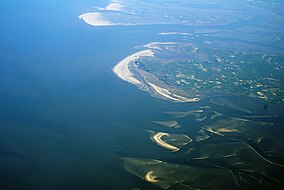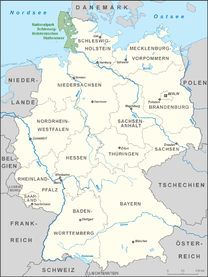
Back Taman Nasional Segara Wadden Schleswig-Holstein BAN Nationalpark Schleswig-Holsteinisches Wattenmeer Danish Nationalpark Schleswig-Holsteinisches Wattenmeer German Parque nacional del mar de Frisia de Schleswig-Holstein Spanish شلسویگ-هولشتاین وادن زا ناتسیونال پارک Persian Parc national de la mer des Wadden du Schleswig-Holstein French Natsionaalpark Waas (SH) FRR Parco nazionale del Wattenmeer dello Schleswig-Holstein Italian シュレースヴィヒ=ホルシュタイン干潟国立公園 Japanese შლეზვიგ-ჰოლშტაინის ვადენზეეს ეროვნული პარკი Georgian
| Schleswig-Holstein Wadden Sea National Park | |
|---|---|
| Nationalpark Schleswig-Holsteinisches Wattenmeer | |
 Aerial photo of Trischen, Eiderstedt and the southern North Frisian barrier islands | |
 The park is located in northern Germany | |
| Location | North Sea coast, Schleswig-Holstein, Address: Webseiten des Nationalparks Schlossgarten 1 25382 Tönning |
| Nearest city | Westerland, Husum. Tönning. Heide |
| Coordinates | 54°27′23″N 8°38′47″E / 54.456302°N 8.646408°E |
| Area | 441,500 ha (1,705 sq mi) |
| Established | 1 October 1985 |
| Visitors | 1,746,293 (in 2002) |
| Official name | Schleswig-Holstein Wadden Sea and adjacent areas |
| Designated | 15 November 1991 |
| Reference no. | 537[1] |
The Schleswig-Holstein Wadden Sea National Park (German: Nationalpark Schleswig-Holsteinisches Wattenmeer) is a national park in the Schleswig-Holstein area of the German Wadden Sea. It was founded by the Parliament of Schleswig-Holstein on 1 October 1985 by the National Park Act of 22 July 1985 and expanded significantly in 1999. Together with the Lower Saxon Wadden Sea National Park, the Hamburg Wadden Sea National Park and those parts of Elbe estuary which are not nature reserves, it forms the German part of the Wadden Sea.
The national park extends from the German-Danish maritime border in the north down to the Elbe estuary in the south. In the North Frisian area, it includes the mudflats around the geest-based and marsh islands and the Halligen (undyked islands). There, the mudflats are 40 km wide in places. Further south lie areas of mudflats which contain particularly large sandbanks. In addition to the plants and animals that are typical of the entire Wadden Sea, especially large numbers of porpoise, shelduck and eelgrass may be seen in the Schleswig-Holstein part.
With an area of 4410 km ² it is by far the largest national park in Germany. Some 68% of its area is permanently under water and 30% is periodically dry. The land element consists mainly of salt marshes. Since 1990, the national park, including the North Frisian Halligen, has been designated as a UNESCO recognised biosphere. Together with other German and Dutch Wadden Sea areas it became a UNESCO World Heritage Site on 26 June 2009 because of its relatively undisturbed intertidal ecosystem and its unique biodiversity.[2]
- ^ "Schleswig-Holstein Wadden Sea and adjacent areas". Ramsar Sites Information Service. Retrieved 25 April 2018.
- ^ "Wadden Sea". UNESCO World Heritage Centre. United Nations Educational, Scientific, and Cultural Organization. Retrieved 26 June 2021.